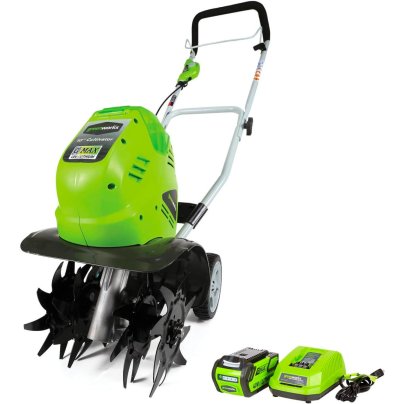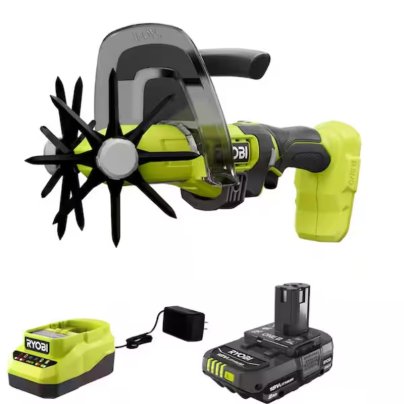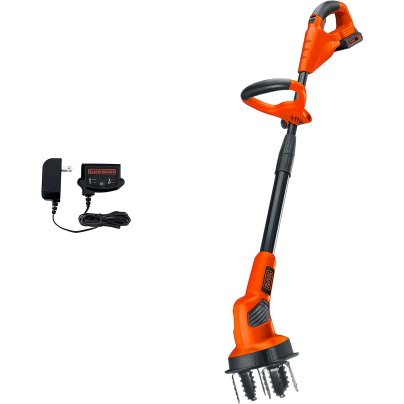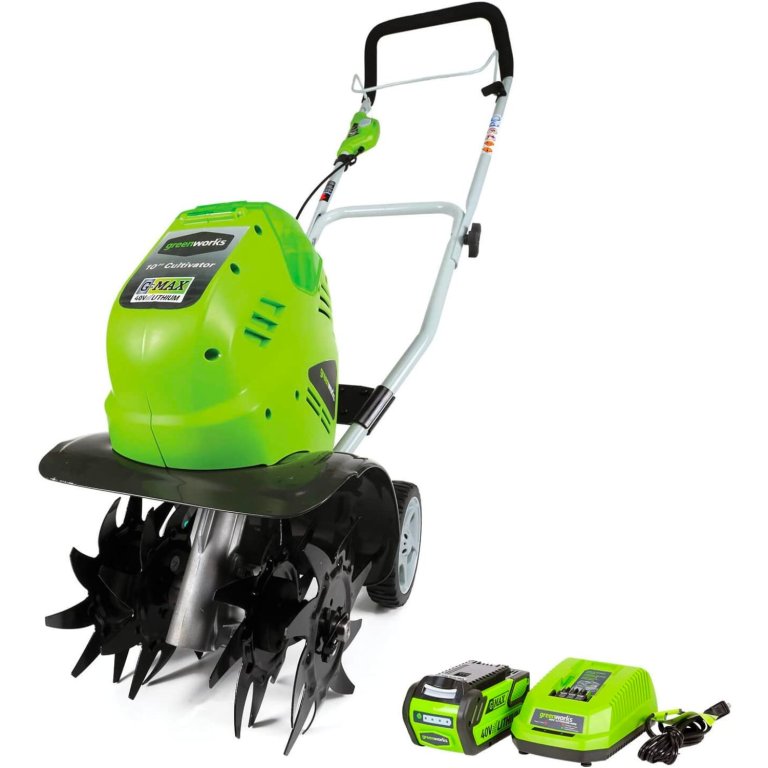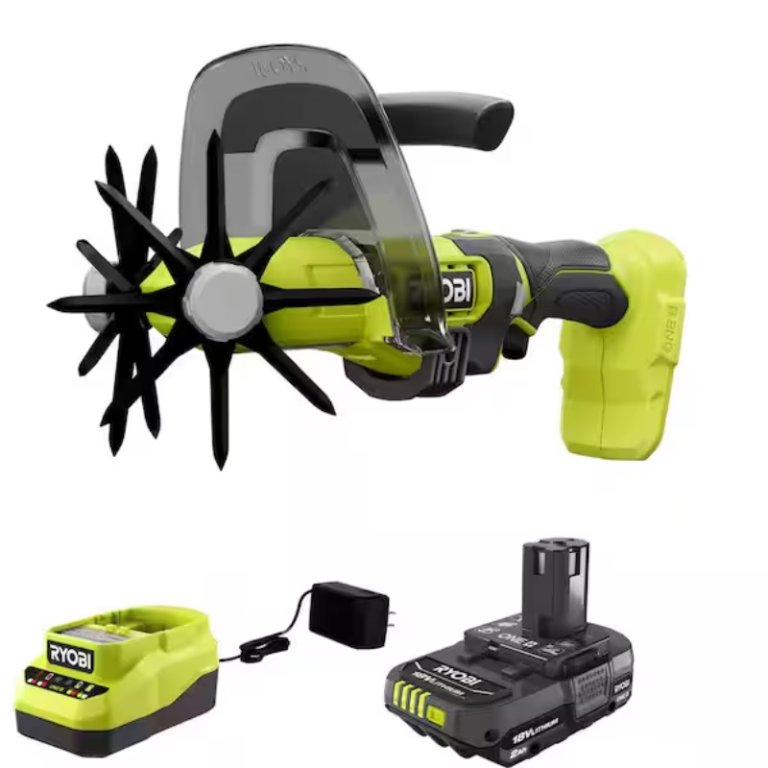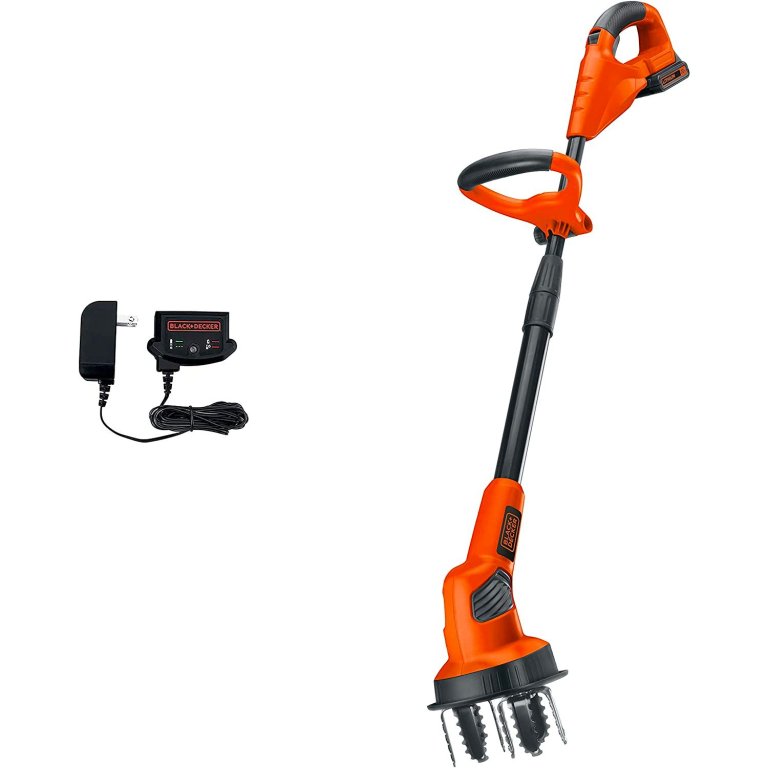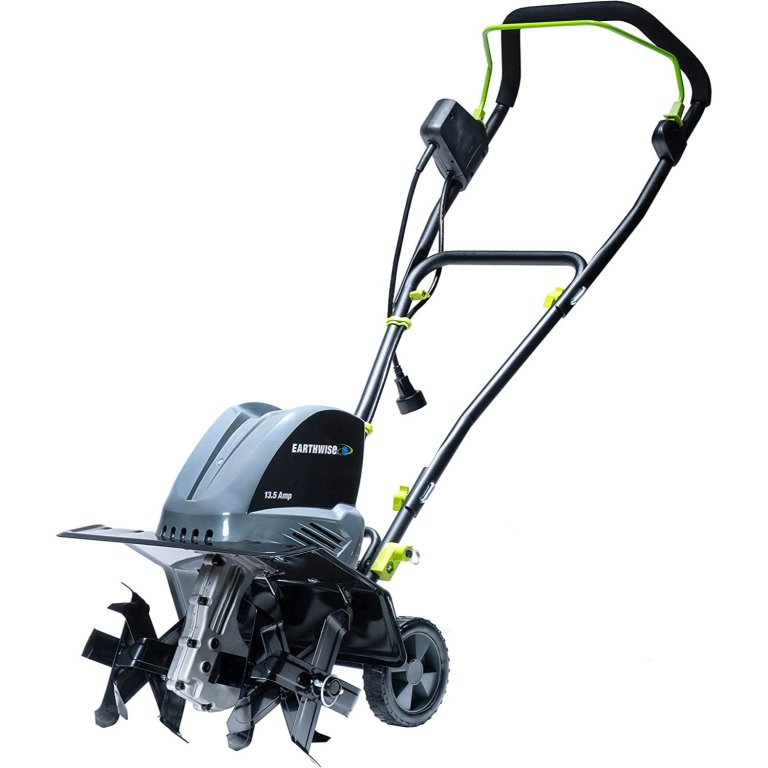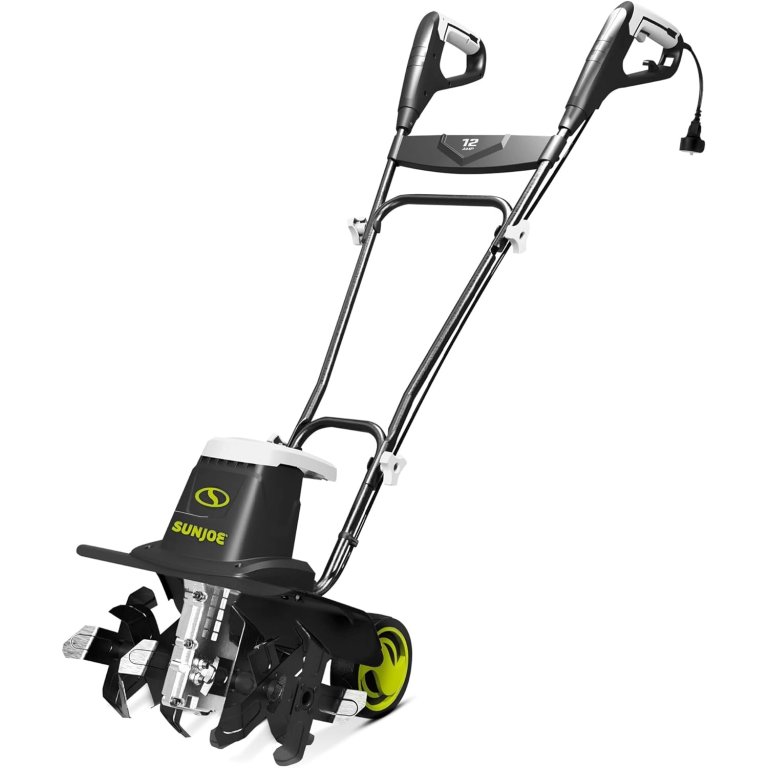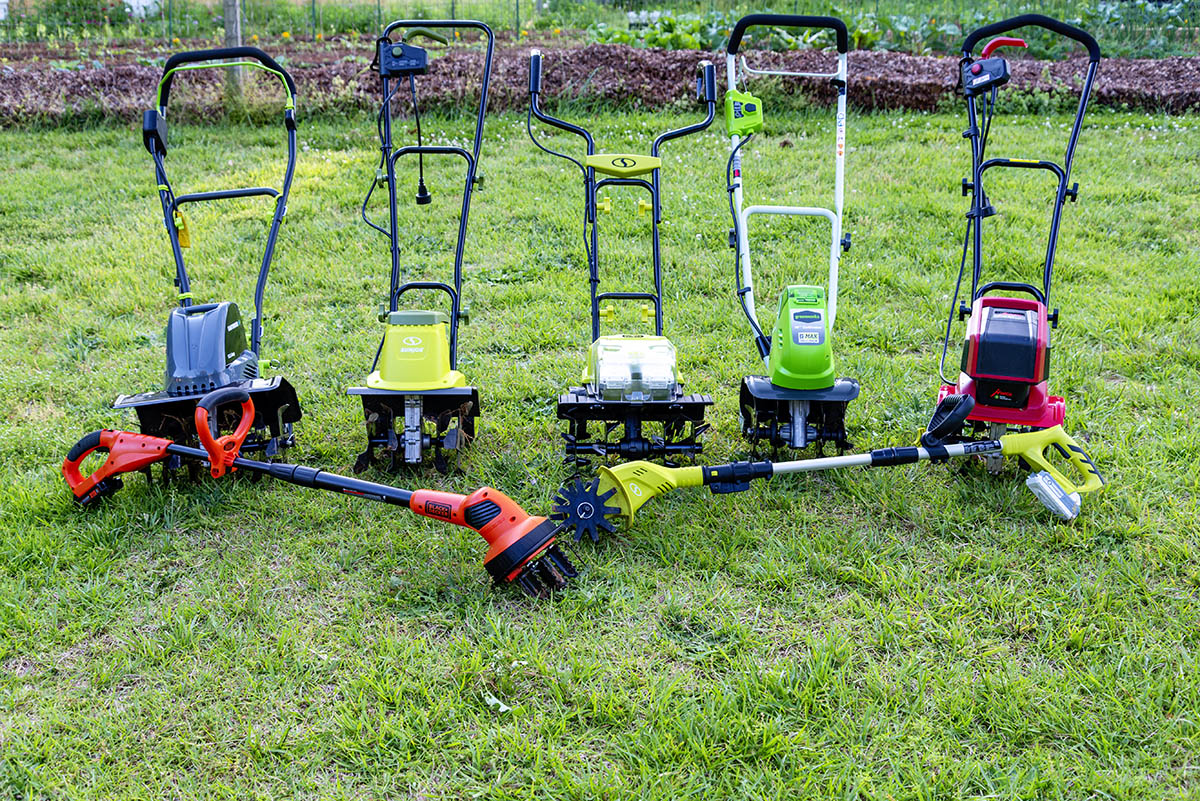
We may earn revenue from the products available on this page and participate in affiliate programs. Learn More ›
An electric tiller uses a series of blades to loosen and aerate hard garden soil, enabling it to both drain properly and maintain adequate moisture that keeps plants hydrated. Sometimes known as rototillers, garden tillers, or cultivators, these gardening tools also help create favorable conditions for symbiotic organisms like beneficial bacteria and worms. Their use even helps to prevent weeds and lets users mix in soil amendments, such as fertilizer.
Tillers come in a range of sizes and with various features, so we put 12 popular products through a series of tests to learn more about their ability to prepare and maintain landscape and garden beds. We also spoke with the owner of a landscaping business to get his opinion on corded and battery-powered tillers.
Based on his insights and our tests, we chose the Greenworks 40V 10″ Cordless Tiller/Cultivator as our top pick. It’s easy to use, performs well in a variety of soil types, and charges quickly to ensure you’ll be able to get your garden ready in time for growing season. Read on to understand more about that model, the other tested picks that made our list, and the criteria we think you’ll want to consider when deciding between the best electric tillers for your next project.
- UPGRADE PICK: Greenworks 40V 10″ Cordless Tiller/Cultivator
↓ Jump to Review - BEST BANG FOR THE BUCK: Ryobi 18V One+ Compact Cultivator Kit
↓ Jump to Review - BEST MINI: Black+Decker 20V MAX Lithium Garden Cultivator
↓ Jump to Review - BEST HEAVY-DUTY: Earthwise 120V 16″ Corded Tiller/Cultivator
↓ Jump to Review - BEST CORDED: Sun Joe 12-Amp 16″ Electric Garden Tiller/Cultivator
↓ Jump to Review - BEST ATTACHMENT:Ego Power+ 9.5″ Cultivator Attachment
↓ Jump to Review
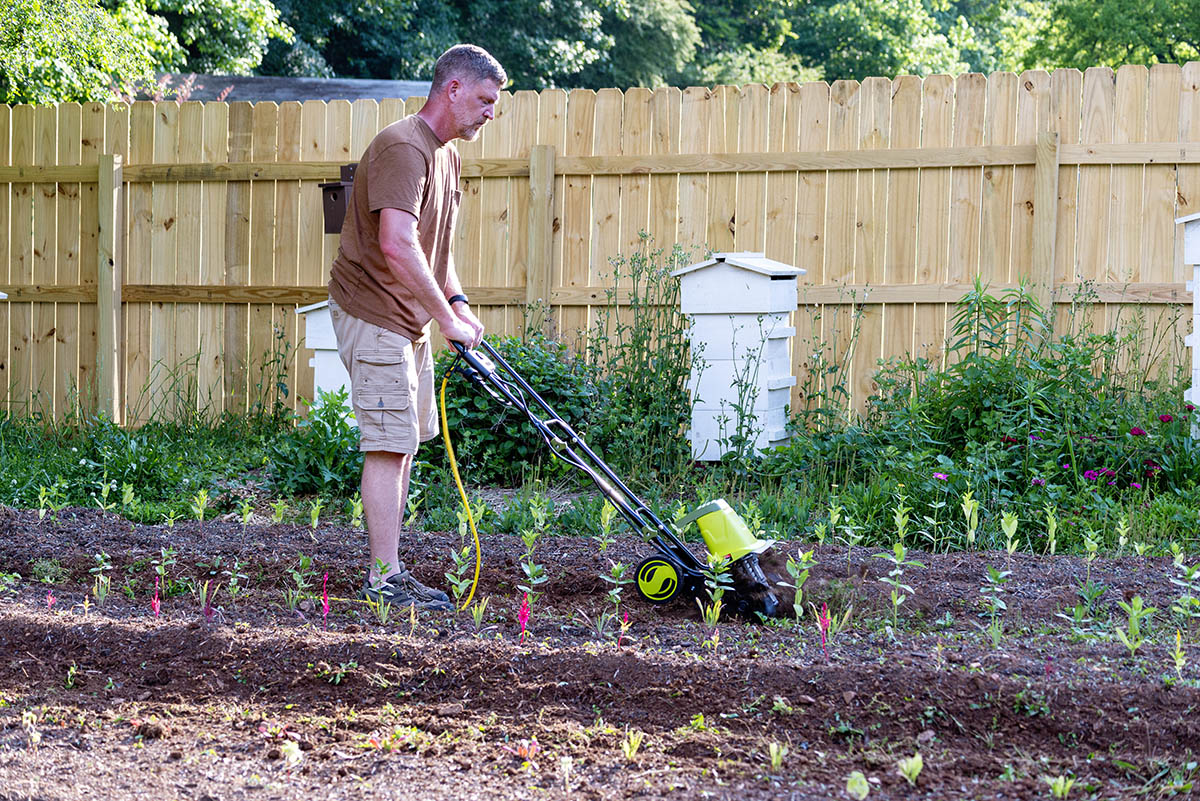
Electric Tillers Comparison Chart
| Product | Power source | Weight | Tilling width |
| Greenworks 40V 10″ Cordless Tiller/Cultivator | 40V battery | 29.3 pounds | 10 inches |
| Ryobi 18V One+ Compact Cultivator Kit | 18V battery | 4.48 pounds | 5.09 inches |
| Black+Decker 20V MAX Cordless Garden Cultivator | 20V battery | 11.73 pounds | 7 inches |
| Earthwise 120V 16″ Corded Tiller/Cultivator | 13.5A motor | 29.1 pounds | 16 inches |
| Sun Joe 12-Amp 16″ Electric Garden Tiller/Cultivator | 12A motor | 27.1 pounds | 16 inches |
| Ego Power+ 9.5″ Cultivator Attachment | 56V battery (sold separately) | 8.6 pounds (attachment only) | 9.5 inches |
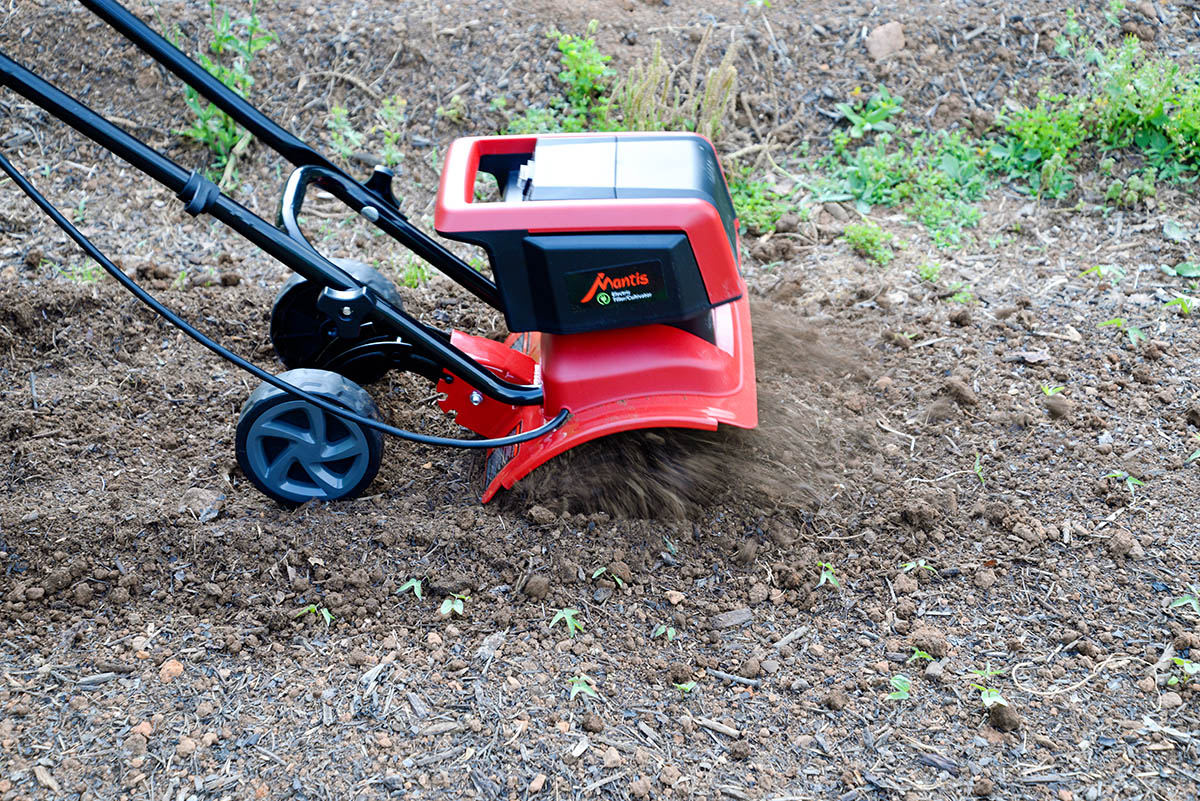
Our Top Picks
The following curated picks are our favorites from our tests. To choose the right one (and skip worrying about how to till a garden without a tiller), we recommend you review their ratings and consider their pros and cons.
Best Overall
Greenworks 40V 10" Cordless Tiller/Cultivator
What We Like
- Cordless construction offers freedom of movement
- Easy to carry
- Width is adjustable to suit different areas
What We Don’t Like
- Battery recharge takes 2 hours
Product Specs
- Power source: 40V battery
- Weight: 29.3 pounds
- Tilling width: 10 inches
Our Ratings
| Ease of Use | 4.5/5 | Performance | 4.5/5 | Durability | 4/5 | Value | 4.3/5 |
While corded tillers offer plenty of advantages, cords can get in the way during operation and limit tilling located far from an outlet. With its 40-volt rechargeable lithium battery, this Greenworks cordless tiller cultivator is a great alternative to a plug-in model. Its four tines till to a depth of 5 inches and are adjustable to a max width of up to 10 inches. Since it’s somewhat compact, it’s a good choice for small to medium-size gardens and for those focused on finding a tool that’s easy to operate and store. This pick runs up to 40 minutes on a single charge and takes about 2 hours to recharge.
When we began our testing, we were more familiar with corded tillers, so we were pleasantly surprised by how easy this Greenworks cordless model was to operate and how well it performed. It tilled all types of ground quickly and thoroughly, including compacted garden paths and dense clay-based soil. The padded hand grip was comfortable and made it easy to control the machine, and the 1-second delay gave us time to get both hands in position before the tines started spinning. We also appreciated being able to configure it with either two or four tines to change the tilling width from 8.25 inches (for close cultivation) to 10 inches (for general tilling). As a powerful, easy-to-use, and compact tool for use and storage in tight quarters, we think this tiller will meet the needs of a wide range of users.
What our tester says: “I was blown away by how fast and aggressive this cordless tiller was, even in hard-packed garden paths and clay soil. It’s compact, powerful, and surprisingly easy to control.”—Mark Wolfe, Product Reviews tester and writer
Get the Greenworks electric tiller at Amazon, Tractor Supply Co., Walmart (tool only), Northern Tool + Equipment, or Greenworks.
Best Bang For The Buck
Ryobi 18V One+ Compact Cultivator Kit
What We Like
- Lightweight and compact design
- Excellent value for occasional use
- Battery is compatible with other One+ tools
What We Don’t Like
- Tilling width isn’t adjustable
- Requires kneeling unless working on a raised bed
Product Specs
- Power source 18V battery
- Weight 4.48 pounds
- Tilling width 5.09 inches
Our Ratings
| Ease of Use | 4.5/5 | Performance | 4/5 | Durability | 4/5 | Value | 4.7/5 |
If you’re looking to maintain a well-groomed garden without breaking the bank, this compact cultivator from Ryobi might be just what you need. As a handheld unit, it’s ideal as a tiller for a raised bed garden or a similarly small space. Despite its size, it offers three powerful speeds between 176 and 233 revolutions per minute (RPM). It features a front handle and debris guard for enhanced control and safety, plus removable metal tines that make it easy to clean.
As big fans of Ryboi products, we were impressed by the brand yet again when testing this tiller. The kit comes with an 18-volt 2.0 Ah battery and charger that are compatible with dozens of other One+ tools. In our tests, we worked in front of our shed, along our fence, and in a landscaping bed for about half an hour before the battery ran out of power. Considering how small this tiller is, we were pleasantly surprised by how easily it churned through compacted soil and a neglected landscaping bed, though it wasn’t quite strong enough for a rocky area. That’s probably for the best, considering you have to kneel to use this model, which puts your face pretty close to the action, debris guard or not.
What our tester says: “This is my go-to for maintenance cultivation. I love how small and lightweight it is, yet it’s still powerful enough to churn through my garden and get it ready for planting.”—Michelle Larson, Product Reviews tester and writer
Get the Ryobi electric tiller at The Home Depot.
Best Mini
Black+Decker 20V MAX Cordless Garden Cultivator
What We Like
- Lightweight and easy to use
- Gentle stirring action thoroughly cultivates soil
- Budget-friendly price compared to similar tiller models
What We Don’t Like
- Short runtime per charge of just 20 minutes
- Recharging takes 8 hours
Product Specs
- Power source: 20V battery
- Weight: 11.73 pounds
- Tilling width: 7 inches
Our Ratings
| Ease of Use | 4.5/5 | Performance | 3.5/5 | Durability | 4/5 | Value | 4/5 |
With its compact profile and user-friendly design, this mini tiller from Black+Decker is handy for preparing small garden beds for planting or cleaning up dead spots in the yard for seeding. It comes with a 20-volt battery that provides enough power to till up to 350 square feet per charge. It features a soft grip, adjustable handle, and telescoping tube for comfort and counter-oscillating tines that prevent weeds from tangling.
In our tests, there were two things we especially liked about this Black+Decker light-duty cultivator. First, its lightweight, balanced design virtually eliminates user fatigue. Second, its uniquely designed tines spin on a vertical axis like eggbeaters instead of on a horizontal shaft like other tiller tines. It essentially stirs the soil to remove weeds and break up crusted surfaces, which is a remarkably effective approach. Unfortunately, its runtime is short at about 20 minutes, and it takes a whopping 8 hours to recharge. Those looking to tackle bigger projects may want to buy a second battery, but considering how great this model is for reducing weed pressure among garden seedlings, we think that’s worth it.
Get the Black+Decker electric tiller at The Home Depot, Walmart, or Black+Decker.
Best Heavy-Duty
Earthwise 120V 16" Corded Tiller/Cultivator
What We Like
- Maximum tilling width of 16 inches, 8-inch depth
- 13.5A motor powerful enough for tough tasks
- Corded operation means unlimited runtime
What We Don’t Like
- Too large for cultivation in tightly planted areas
- Garden hoes break up roots more effectively
Product Specs
- Power source: 13.5A motor
- Weight: 29.1 pounds
- Tilling width: 16 inches
Our Ratings
| Ease of Use | 4.3/5 | Performance | 5/5 | Durability | 5/5 | Value | 4.7/5 |
For gardeners tackling medium to large plots, this Earthwise electric tiller cultivator offers the power needed to get the job done quickly. Its 13.5A (amp) corded electric motor and six steel tines can till a 16-inch-wide swath up to 8 inches deep, making it ideal for breaking new ground, even in heavy clay-based soils. It also features an ergonomic padded handle that reduces vibration and eliminates slippage for more comfortable operation.
At 29.1 pounds, this was one of the heaviest tillers we tested, but the added weight helped it to power through tough areas smoothly. The sturdy build also gave it a stable, grounded feel, which made it easy to control. However, when we tested it in an area with tall, coarse weeds, the tines quickly became clogged with thick roots and vegetation. And when we adjusted the width down to 11 inches, the tine shield partially blocked our view of the soil, though it did allow us access to narrower spaces. Despite these drawbacks, this Earthwise model proved to be a dependable workhorse for heavy-duty tasks.
What our tester says: “After testing this unit, I thought it would make a great tool for a gardener who mainly intends to use it for bed preparation and pathway maintenance.”—Mark Wolfe, Product Reviews tester and writer
Get the Earthwise electric tiller at Amazon or Walmart.
Best Corded
Sun Joe 12-Amp 16" Electric Garden Tiller/Cultivator
What We Like
- 12A motor is powerful enough for tough soil
- Maximum tilling width of 16 inches, 8-inch depth
- Instant start with a safety switch
What We Don’t Like
- Cord requires wrangling during use
- Getting the proper angle takes practice
Product Specs
- Power source: 12A motor
- Weight: 27.1 pounds
- Tilling width: 16 inches
Our Ratings
| Ease of Use | 4.1/5 | Performance | 5/5 | Durability | 5/5 | Value | 4.7/5 |
Sun Joe’s corded electric tiller is a solid pick for homeowners cultivating small to medium-size plots. Powered by a 12A motor, it uses six angled tines made of steel to till up to 16 inches wide and 8 inches deep, which is more than sufficient for most residential tasks. It also has a safety switch that prevents accidental starts and a handle trigger that allows instant stops. The handle folds to reduce storage space, and the wheels adjust to three heights to enable everything from shallow surface mixing to breaking new ground.
In our tests, the Sun Joe was the model we chose when we wanted to cover a lot of square footage quickly. It chewed through compacted soil with ease, and its relatively light weight of just over 27 pounds made it easy to maneuver. Since it is quite powerful, we appreciated the safety switch and trigger, though it did take us a minute to get comfortable holding down the trigger while angling the machine properly. After using quite a few cordless tools, there was also a bit of a relearning curve to keeping the cord out of the way, especially when we were moving fast. Unless you need a tiller that can accommodate narrow spaces as well as wide ones, this pick is a winner in terms of power and depth.
Get the Sun Joe electric tiller at Amazon, Walmart, Target, or Sun Joe.
Best Attachment
Ego Power+ 9.5" Cultivator Attachment
What We Like
- Spring-loaded tines adjust to terrain
- Durable steel shaft and large safety guard
- Adjusts from 8 to 9.5 inches wide
What We Don’t Like
- Requires compatible Ego base and battery (sold separately)
- Neither attachment nor compatible base are height adjustable
Product Specs
- Power source: 56V battery (sold separately)
- Weight: 8.6 pounds (attachment only)
- Tilling width: 9.5 inches
Our Ratings
| Ease of Use | 4.4/5 | Performance | 5/5 | Durability | 5/5 | Value | 4.3/5 |
If you’ve already invested in the Ego Power+ multi-head system (or are considering it), this 9.5-inch cultivator is an easy choice. Designed for convenience and versatility, this attachment quickly converts a compatible power head into a capable handheld tiller. The cultivator features an adjustable width between 8 and 9.5 inches and tills to a depth of 8.5 inches. It’s outfitted with four spring-loaded steel tines that automatically adjust to ground contours to help reduce user fatigue. In terms of power, this is the beefiest cordless model on our list, thanks to Ego’s 56-volt battery (sold separately), which delivers gas-like performance without the noise, fumes, or maintenance.
During testing, we needed all the help we could get in terms of minimizing fatigue, given that the attachment, power head, and battery have a combined weight of almost 20 pounds. While that may not seem excessive, it quickly wore out our shorter and less-fit tester. The lack of height adjustment on the power head and attachment means its ergonomics aren’t exactly one size fits all, making it a lot to wield for some. That said, we have absolutely no complaints in terms of this pick’s performance. It had no problem powering through compacted soil in our garden bed or breaking new ground in a rocky area. Add that to the fact that you can swap in a number of other Ego attachments, including a string trimmer, a pole saw, or even a shovel, and this becomes a truly all-season landscaping tool.
What our tester says: “This wasn’t my favorite tiller to use, but it was my husband’s. I could barely pry it out of his hands. He must’ve walked around our yard for an hour looking for additional areas that needed attention, which I guess is okay since now I get to plant in all those places.”—Michelle Larson, Product Reviews tester and writer
Get the Ego electric tiller at Amazon, Lowe’s, or Ace Hardware.
Jump to Our Top Picks
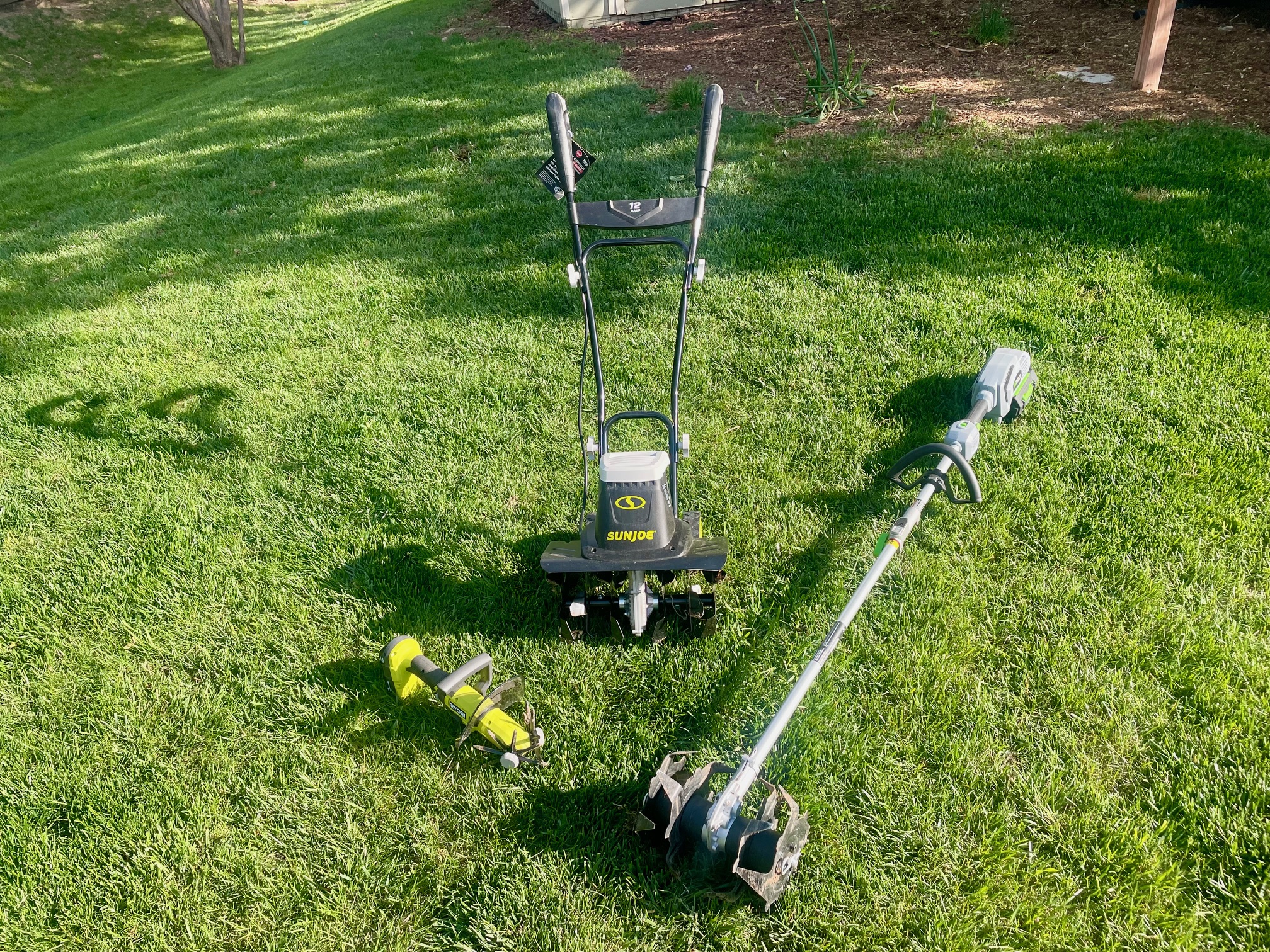
How We Tested the Best Electric Tillers
| Testing Stats | |
| Products tested | 12 |
| Time spent testing | 11 hours |
| Tests performed | 7 to 8 |
| Price range | $100 to $350 |
We tested three types of electric tillers: corded and cordless tiller/cultivators with wheels and cordless handheld cultivators. While they are all designed to do the same basic thing—turn dirt and soil—each type has unique features that solve specific gardening problems. To fairly evaluate their performance, we set up a test site that allowed us to assess both basic functionality and specialized capabilities, and also used them in additional areas around our property.
We tested each electric tiller/cultivator in previously unbroken clay-based soil, established garden beds, and weedy garden pathways. We also used each electric hand tiller to cultivate and weed among seedlings in a recently planted garden patch.
For the wheeled tillers, we looked primarily at how well they broke up hard soil, but we gave them bonus points for smooth operation, easy maneuverability, and operator comfort. Since lightweight handheld cultivators are designed for light-duty tilling of existing beds and as weeding tools for use among garden plants, we assessed them for ease of use, a high level of control, and a well-balanced design for operator comfort.
| Product | Ease of Use | Performance | Durability | Value |
| Greenworks 40V 10″ Cordless Tiller/Cultivator | 4.5/5 | 4.5/5 | 4/5 | 4.3/5 |
| Ryobi 18V One+ Compact Cultivator Kit | 4.5/5 | 4/5 | 4/5 | 4.7/5 |
| Black+Decker 20V MAX Cordless Garden Cultivator | 4.5/5 | 3.5/5 | 4/5 | 4/5 |
| Earthwise 120V 16″ Corded Tiller/Cultivator | 4.3/5 | 5/5 | 5/5 | 4.7/5 |
| Sun Joe 12-Amp 16″ Electric Garden Tiller/Cultivator | 4.1/5 | 5/5 | 5/5 | 4.7/5 |
| Ego Power+ 9.5″ Cultivator Attachment | 4.4/5 | 5/5 | 5/5 | 4.3/5 |
What to Consider When Choosing an Electric Tiller
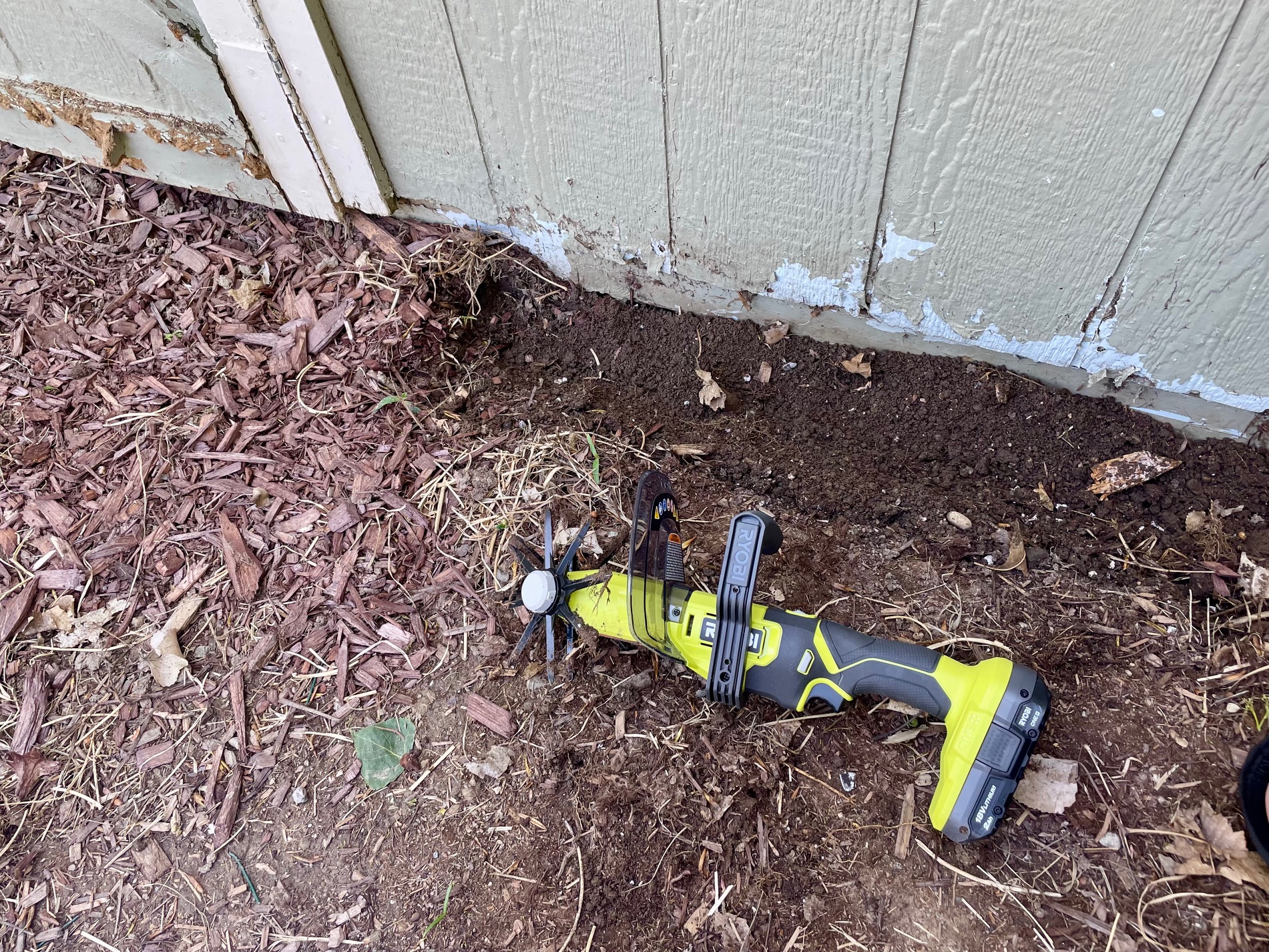
There’s no one-size-fits-all electric tiller for solving the question of how to till a garden. According to David McCary, owner of Seattle Sustainable Landscapes, the types of projects you need a tiller for play the biggest part in choosing one. “The most important thing to consider is what is important to you, how you will use the tool, and how frequently you will use the tool.”
To answer these questions, look at the factors that affect the tiller’s performance. Its power source, tines, size, power and speed capabilities, and ease of use impact how well it will work for your project.
Corded vs. Cordless
Electric garden tillers come in both corded and cordless (battery-powered) models, each offering different power outputs and runtimes. “Electric tillers are ideal for homeowners who do not need to use the tiller all day or who do not have a huge project that requires more power than an electric tiller can produce,” says McCary. Those with large-scale projects may want to consider renting a motorized tiller that runs on gas for a project’s initial phases and buying a corded or battery-powered tiller for ongoing work.
Most corded tillers are more powerful and less expensive than their battery-powered counterparts. They also offer virtually unlimited runtime, unlike cordless tillers, whose runtimes depend on battery capacity. However, corded tillers only cover as much ground as the power cord or extension cord can reach, and dragging a cumbersome electrical cord around the garden can be an inconvenience as well as a safety hazard.
To address these limitations, retention hooks on corded tillers keep the cord away from the machine’s wheels and blades. Still, cordless tillers offer unbeatable portability and maneuverability. These models usually have runtimes between 30 and 60 minutes, but gardeners can extend that by keeping a few spare batteries on hand.
Tines
On a garden tiller, a set of blades or rotating tines churns the soil. While tillers may include two, four, or six individual tines, most models have four tines, either at the rear of the tool, on the front, or in the center, directly under the motor.
- Rear-tine tillers usually pack the most power and can cut deep into soil. They’re an ideal option for heavier and more compacted soils.
- Front-tine tillers, the most common type, generate less power than rear-tine options, but that reduction in power tends to make them more nimble, so they tend to be easier to push and maneuver.
- Mid-tine tillers offer a combination of the power of a rear-tine tiller and the ease of use of a front-tine tiller, making them a popular general-purpose option. However, mid-tine electric tillers aren’t as common as other types.
Size
A tiller’s size refers to the cutting tines’ width and depth of penetration into the ground. As a general rule, the wider the tiller, the fewer passes users must make to till a desired area. The size of the tines determines the maximum depth a tiller can penetrate into the soil. Larger tines go deeper into the soil but tend to make these gardening tools more difficult to maneuver.
The width of electric tillers’ cutting tines typically ranges from 6 to 20 inches. Some models include adjustable tines to manipulate the width, which makes the tiller more versatile. Although wider tillers cover more ground, their bulkier size makes them more difficult to maneuver in tight spaces. Small garden tillers are narrower and work well in raised beds and between rows of plants.
An electric tiller’s maximum working depth typically falls between 6 and 8 inches, with greater depths more suitable for breaking ground. Small tillers for gardening typically operate at shallower depths that are more in line with seasonal loamy soil preparation and maintenance needs.
Power and Speed
An electric tiller’s power is measured in amps for corded tillers and volts for cordless ones. A corded tiller will usually have power ratings between 2.5 and 14 amps, and a cordless electric tiller generally has a rating of 20V or 40V. Naturally, larger tillers require more power to accommodate the greater demand.
An electric tiller’s speed is determined by how many revolutions per minute the tines make when tilling the soil. Tines churn the soil fastest and most effectively at a higher RPM. An electric tiller’s tines can turn at rates of 150 to 400 RPM, but 150 usually isn’t enough. The best rototillers will operate at a minimum of 180 RPM to reap the full benefits of tilling.
Ease of Use
Naturally, a larger and heavier tiller will be more difficult and cumbersome to use than a smaller and lighter tiller. Larger tillers cover more ground more quickly, but they require more effort on the part of the gardener to do so. A tiller with adjustable tines lets gardeners find the ideal middle ground between performance and ease of use.
Many of the best electric tillers include sturdy wheels that help them move with greater ease over hard surfaces. They may also have ergonomic handles to make extended use more comfortable. Some tillers feature adjustable handles that allow users of various heights to extend or retract them, and models with collapsible handles make the tiller easier to store when not in use.
Safety
Any piece of equipment with exposed, fast-spinning blades requires special safety considerations. To minimize the risk of injury, look for an electric tiller with common safety features, such as a push-button motor start as well as metal guards behind the tines to prevent rocks and other potential projectiles from hitting you.
Keep the following safety tips in mind when preparing the area for tilling and operating the tool:
- Before using the tiller for the first time, read the provided user manual to familiarize yourself with the tiller’s controls and operating procedures.
- Practice shutting the motor off quickly in case of an emergency.
- When operating a tiller, wear the appropriate safety gear, including safety glasses, proper footwear (closed-toe and nonslip), long pants, a long-sleeved shirt, and earplugs.
- Before tilling the soil, remove stones, sticks, and other foreign objects from its path.
- Be mindful of any gas, electric, or water lines that might be buried in the area to avoid damaging them.
FAQs
Still want more info about electric tillers? Discover answers to several of the most frequently asked questions below to avoid making any gardening mistakes that can kill your plants.
The main difference in cultivators vs. tillers is their size, which impacts how they’re used. Cultivators, usually smaller than tillers, are primarily designed to mix and loosen shallow sections of soil that have been tilled previously. Tillers, on the other hand, break up larger sections of harder soil. Tillers aid in creating new garden beds, while cultivators help prepare existing beds for planting.
The tilling capacity of an electric garden tiller refers to how deep and wide it can till.
Tillers aren’t the best choice for removing grass because they cannot get the entire job done. Ideally, to remove established lawn grass, one should rent a sod cutter for large areas. For smaller portions of grass, use a garden spade to slice the roots beneath the surface. A heavy-duty gas-powered tiller can partially remove grass by freeing the roots from the soil and breaking large sections of sod into smaller chunks. Unfortunately, you’ll still have to remove the smaller chunks with a garden fork or a shovel after using a gas tiller.
Walk-behind tillers, both electric and gas, are designed to work in a forward direction. Attempting to pull them backward can lead to injury. The forward rotation of the tines usually provides adequate forward momentum, so it is normally not necessary to push the machine. Depending on soil conditions, it may be necessary to rock the machine forward or hold back on forward momentum for best results.
Electric tillers are great for ongoing maintenance and smaller projects. According to McCary, “Performance is typically best for gas-powered equipment, both in power and longevity of use.” However, gas tools are generally harder to start, require winterization, and create sound and air pollution.
The electric tillers included in this guide typically cost between $100 and $350.
Meet the Tester
Mark Wolfe is a writer and product tester with a background in the nursery and landscaping industry. For more than 20 years, he mowed, edged, planted, pruned, cultivated, irrigated, and renovated beautiful landscapes. Now he tests and writes reviews about the latest outdoor power equipment, hand tools, lawn-care products, and other outdoor-living goods.
Michelle Larson has been a writer and editor for more than 10 years in the fields of health, business, and the home. She enjoys testing tools like electric tillers because they’re practical, efficient, and help her make more room to do what she really loves: garden.
Additional research provided by James Fitzgerald and Tony Carrick.
